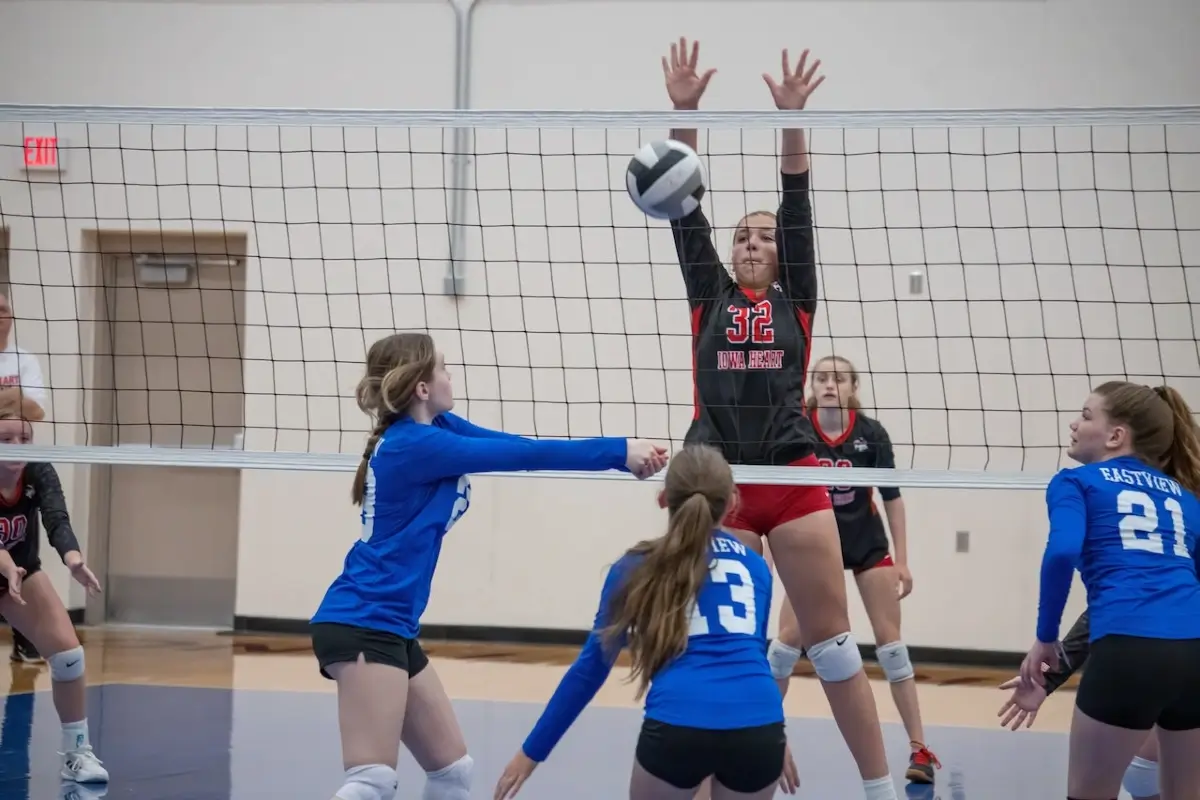Last Updated: January 9, 2024
If you want to be an effective volleyball player you have got to master some defensive volleyball drills. This is what “separates the men from the boys” and can significantly change the outcome of the game.
If you are seeking to improve the quality of your play, defense is something you really need to work on, and here are some essential defense drills that you can always count on.
8 Defensive Drills to Improve Your Volleyball Game

1. The Balancing the Court
This drill requires teamwork. Every defensive player needs to cover a significant portion of the court in order to fill up any unoccupied portions. You don’t want to leave any gaps unattended as these could easily be used against you.
You basically want to have a maximum of 4 players to implement this drill. 3 of them will have to play defensively and 1 of them will be the hitter.
During the start of the drill, all 4 players spread throughout the court with the hitter standing near the net. The objective of the hitter is to direct the ball toward any unoccupied portion of the court. In the meantime, all the defensive players have to be on high alert to control the hit.
Ultimately one of the defensive players has to calm it down and pass to another defensive player who will in turn make a final pass to the hitter. And just like that another round of the “Balancing the Court” drill begins.
2. The V8 Block
The V8 platform drill is essential for developing vertical jumping abilities. Vertical jumping prowess is important for enhancing the defensive abilities of your team.
Well, the V8 platform has the capability to load the arms and legs at the same time when jumping. All you need to do is connect the platform’s resistance bands to the player’s arms (wrists) and waist.
Then a hitter, usually positioned on the opposite side of the court hits the ball toward the general direction of the strapped player. The goal of the player on the V8 platform is to leap and block/deflect the ball accordingly.
This should be done 15 to 20 times each time ensuring that the resistance bands don’t go slack so the player puts forth maximum effort – for optimal power development.
Recommended read: 7 Common Volleyball Blocking Mistakes to Avoid
Once again, this drill is important for maximizing the player’s athletic potential.
3. The Touch Ten
This is a really simple drill that helps improve hand-eye coordination and promote quick reaction. You need two players to perform this drill (alternatively a coach and a player).
Have the player on one side of the court and their partner on the other half. The partner should toss the ball over the net but in the general direction of the player. The player should touch the ball 10 times before kicking it back to the partner.
This is a good drill to help one improve their ball control techniques and can be repeated severally.
4. Quick Reaction Defensive
Volleyball is a game that requires one to be on high alert always and swift in response. Therefore, this drill is one that is highly essential. To perform it you need two partners – one of them being a player and the second being a coach or just another player.
So, the player will stand in front of the net with the coach or partner on the other side of it. The partner will simply toss the ball over the net and the player must react swiftly in order to block the attack.
This is a pretty basic drill but one that should be practiced regularly in order to build one’s situational awareness. The drill should be repeated severally per session.
5. The Watch the Hitter
Every team needs to have optimal ball blocking abilities in order to make the most of each game and this drill aims to help accomplish exactly that.
You need at least three players to accomplish this drill – and one partner, a coach is possible. Two of the players will play as blockers and the other one will be a hitter located on the other side of the net.
To start the drill, the ball will need to be tossed from behind the blockers to the opposite side of the court to the hitter. The hitter then preps the ball for attack with the blockers watching his every move.
The goal is to train the blocks to keep track of the hitter and to defend appropriately once an attack is initiated.
You can take things a notch higher by turning this into a competitive drill whereby whenever the ball is successfully blocked, the blocker earns two points and whenever the attack is successful the hitter earns two points. The first person to reach 20 points can be rewarded accordingly.
Related: Volleyball Blocking Drills for Perfect Timing
6. The Bad Set
You need at least two volleyball teams in order to successfully use this drill. As usual, the teams have to occupy two opposite ends of the court with their players assuming defensive positions.
As all the players will be in defensive mode, the coach will need to be the one to play the setter’s role. So, they need to be positioned at the right front section of the court.
The coach will toss the ball while trying their best to imitate real game conditions. This allows the two teams to play until a score is made before another toss can be done again. 5 tosses should be done before the teams eventually switch sides.
7. The Resisted Spike
Part of mastering good defensive play techniques is to improve the players’ stability during liftoff and landing. That’s where the resisted spike drill comes in, even though spike is clearly an attacking shot.
With this drill, a 360-degree belt is attached to the player’s waist effectively attaching some resistance bands to them. This creates both horizontal and vertical loading vectors working against the motion of the player.
The player is required to perform their movements, including takeoff, as usual. However, since the athlete is facing some level of resistance, they will have to improve their skill in order to maintain stability.
That’s the whole point of this drill, to help the player play naturally and keep their stability even in extreme situations – a key thing in defensive play.
8. The One-on-One Defense
This drill is all about improving your reaction time, body movement, and hand-eye coordination. It involves two people – preferably one of them being a player, the other one a coach.
To perform this exercise, have the coach toss or spike the ball at the player. The coach should try their level best to be unpredictable and challenging as if to mimic a real-life game scenario.
The player is required to make a defensive play with the routine being repeated severally. It is possible to make this extra fun by giving the player a score for each one of the successful defenses he makes.
By practicing this drill regularly, you can improve your overall defense tactics and reaction time enabling you to anticipate the opponent’s moves with ease.
Conclusion
Every volleyball player needs at least some level of defensive skills in order to perform better in real-game scenarios. Luckily, there are numerous ways through which you can achieve that objective.
Whether be it by practicing using special equipment or simply tagging along with partners, there are endless possibilities when it comes to elevating your volleyball game.
